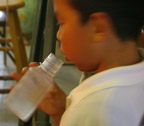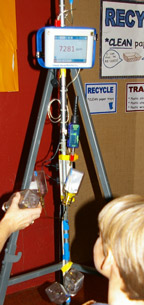
Climate Change Education .Org:
Mobile Climate Science Labs
Carbon Dioxide / CO2
Sources and Sinks; Seeing the invisible all around us;
 |
Climate Change Education .Org: Mobile Climate Science Labs Carbon Dioxide / CO2 Sources and Sinks; Seeing the invisible all around us; |
|
| Labs > Themes > CO2 > Index |
|
• Carbon Dioxide(CO2)
• Earth's Atmosphere • Electrical Power • Energy • Evidence & Global Warming • Food Choices • Green Careers • Heat Trapping Gases (Greenhouse Effect) • Human Health • Infrared • Literacy, Climate • Molecules • Oceans • Ocean Acidification • Oxygen & Photosynthesis • Planets & Space • Reflection & Absorption (Albedo) • Sea Level Rise • Solar Balloon • Sun/Solar Energy • Temperature • Testing Demos • Transportation • Visible to Infrared • Water • Careful! Avoiding "cold fusion" demos  
 Carbon Dioxide Sensor 
 
America's online library for Education & Research in Science, Technology, Engineering, Mathematics:  |
Introduction: Getting to know CO2 levels; Seeing the invisible all around us.
Observing how much higher the CO2 is in what you breath out Compared to what we breath in. Experience the dramatic difference.
People of all ages become aware of levels, comfortable with ppm
Comparing amounts of carbon dioxide released by different human activity.
by various human activity -- one kilogram of carbon dioxide is produced by: 24 hours of breathing by an adult (2 days by a small child). NOT a large amount. Easily absorbed by a large tree, Earth's natural cycles can handle with no problem. By comparison, the same amount is released in 3 minutes by one car [if a 30mpg vehicle at 60 miles per hour]. The burning of jet fuel to keep one passenger aloft in a commercial airliner produces the same 1 kilogram of carbon dioxide in 18 seconds. What we do, as individuals and as a society, makes a big difference in emissions. More in depth labs experiment with emissions by various transportion and energy technologies. Characteristics of CO2 molecules-heat trapping gas, compared to N2 & O2
At the American Association for the Advancement of Science conference:  NASA/JPL Climate Science Day Over a thousand high school students take part in climate science labs
Lab Experiments -- examples: Take samples of CO2 produced by cars. Tailpipe emissions. Percentage C02. Calculate volume and rate at different fuel consumption. Measuring the CO2 produced by burning of fuel. Starting with a candle. Calculate amount released by burning of a liter (or gallon) of gasoline.  |
|
©2011 ClimateChangeEducation.Org |